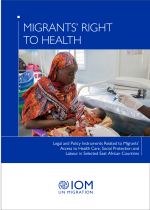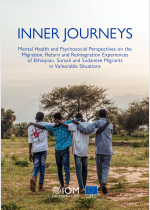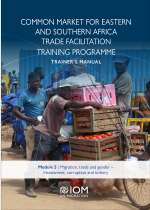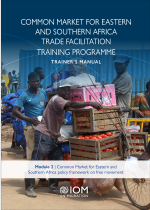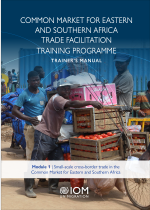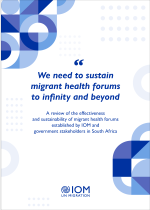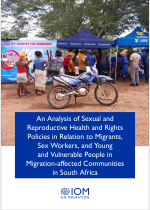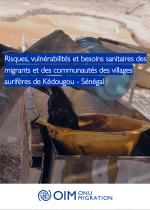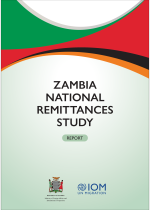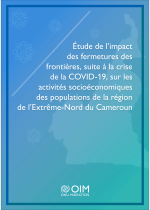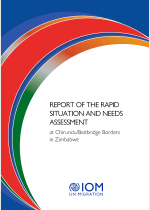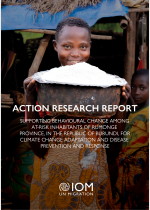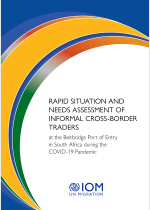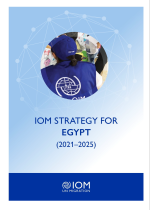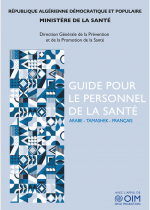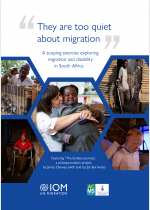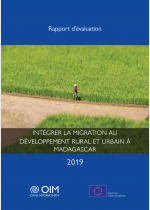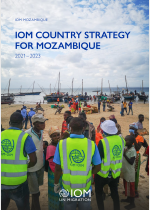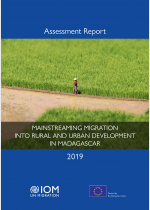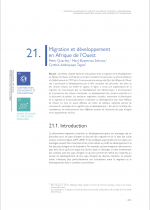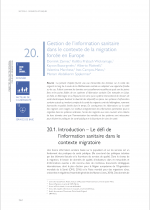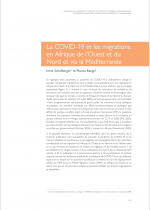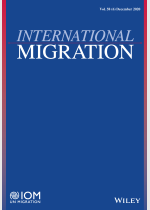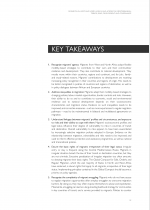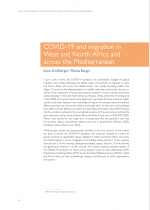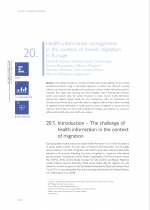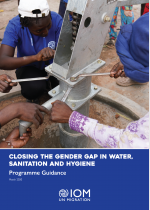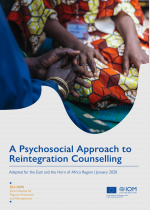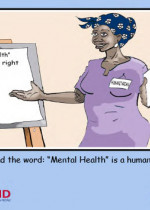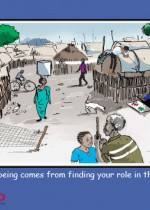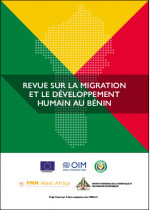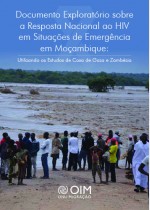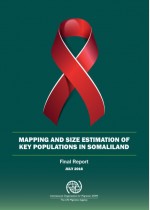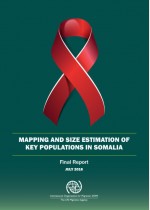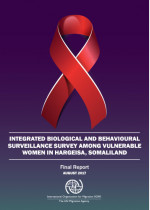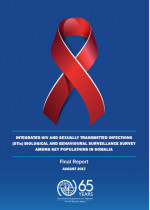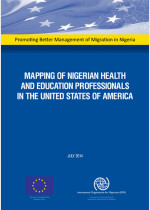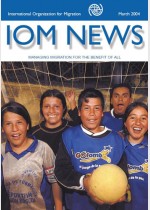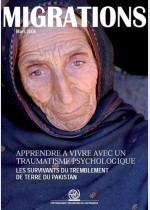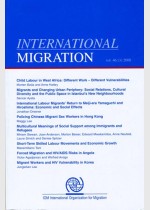Rechercher des livres
Displaying 1 - 50 of 82
This report focuses on a natural experiment-based evaluation conducted as part of the IMPACT study, to better illustrate the effects of the pandemic and other shocks on the wellbeing of returning migrants assisted under the EU-IOM joint Initiative for Migrant Protection and Reintegration in… Read More
The Eastern and Horn of Africa region remains one of the most dynamic regions of the world in terms of migration caused by an evolving complex of economic, social and security interplay. Migrants and mobile populations continue to face many obstacles in accessing essential health-care services… Read More
This study examines the consequences that migration, return and reintegration experiences have on the mental health and the psychosocial well-being of returning migrants, with the primary purpose of informing policies, programmes and advocacy initiatives that promote sustainable reintegration.
This is one of the five modules that make up the Common Market for Eastern and Southern Africa Trade Facilitation and Human Mobility Trainer’s Manual. The Trainer’s Manual was developed to build the capacities of border management agents and policy practitioners in the areas of trade facilitation,… Read More
This is one of the five modules that make up the Common Market for Eastern and Southern Africa Trade Facilitation and Human Mobility Trainer’s Manual. The Trainer’s Manual was developed to build the capacities of border management agents and policy practitioners in the areas of trade facilitation,… Read More
This is one of the five modules that make up the Common Market for Eastern and Southern Africa Trade Facilitation and Human Mobility Trainer’s Manual. The Trainer’s Manual was developed to build the capacities of border management agents and policy practitioners in the areas of trade facilitation,… Read More
This is one of the five modules that make up the Common Market for Eastern and Southern Africa Trade Facilitation Training and Human Mobility Trainer’s Manual. The Trainer’s Manual was developed to build the capacities of border management agents and policy practitioners in the areas of trade… Read More
This is one of the five modules that make up the Common Market for Eastern and Southern Africa Trade Facilitation and Human Mobility Trainer’s Manual. The Trainer’s Manual was developed to build the capacities of border management agents and policy practitioners in the areas of trade facilitation,… Read More
Multisectoral coordination mechanisms are some of the strategies that have been found effective in promoting the health of migrants and their host communities, while at the same time strengthening collaboration and coordination among stakeholders. Since 2008, IOM has supported the establishment of… Read More
Globally and in South Africa, IOM migration health programming seeks to promote the inclusion of migrants in laws, policies and programmes at the global, regional and national levels. Addressing incoherencies in health and non-health policies could reduce the exclusion of vulnerable migrants in… Read More
L’orpaillage, activité pratiquée traditionnellement par les populations locales de la région de Kédougou, a connu un boom aux alentours des années 2010 avec la découverte de filons d’or, ce qui a coïncidé avec l’arrivée massive de migrants de toute la sous-région. Parmi les particularités de l’… Read More
The Government of the Republic of Zambia recognizes the significant contributions of the Zambian diaspora to national development, as reflected in the Seventh National Development Plan, and accordingly formulated a National Diaspora Policy. Following the successful development of the Diaspora… Read More
Following the launch of the Zambia Diaspora Policy in 2019, findings from the online survey of this Zambia National Remittances Study suggest that awareness of the policy among Zambia’s diaspora is quite low. The findings also point to the fact that the implementation of the diaspora policy needs… Read More
L'etude menée par l'OIM sur la pandémie de la COVID-19 apparaît dans un contexte où la crise sécuritaire a rendu vulnérable l'économie de la région de l'Extrême-Nord du Cameroun. Comme dans tous les pays d'Afrique, cette maladie a imposé de nouvelles habitudes aux populations camerounaises. La… Read More
Informal cross-border trade (CBT) is significant in Southern Africa, accounting for between 30 and 40 per cent of total intra-Southern African Development Community trade, with an estimated value of USD 17.6 billion. Women make up approximately 70 per cent of informal traders, face gender-specific… Read More
This report highlights the methodologies, results and lessons learned from the project Enhancing Natural Disaster Preparedness and Response Capacity in at-Risk Communities in Burundi, funded by the IOM Development Fund and implemented by IOM Burundi between September 2019 and August 2021.
Informal cross-border trade (ICBT) is significant in Southern Africa, accounting for between 30 per cent and 40 per cent of the total trade within the SADC, with an estimated value of USD 17.6 billion. Women make up approximately 70 per cent of informal traders. They face gender-specific risks and… Read More
Egypt has been an observer State to IOM since 1974, becoming a full-fledged member in 1991 when IOM established its mission in the country, with its office in Cairo. Soon after entering into an agreement with the Government of Egypt, IOM has established excellent working relations with migration-… Read More
Dans le cadre de la certification de l'élimination du paludisme en Algérie, des difficultés de communication entre les personnels de santé et la population mobile ont été relevés. En effet, malgré l'accès universel et la gratuité des soins de santé, les différences linguistiques peuvent constituer… Read More
Migrants, particularly those living with disability, have often been described as a hidden and hard-to-reach population. A scoping exercise was conducted to shed more light on the nature of migration and disability, with a focus on the extent to which migrants living with disability are included in… Read More
Le chômage, le manque de ressources essentielles et les changements environnementaux font partie des principaux facteurs de migration à Madagascar, ce qui engendre des tendances migratoires complexes tant au niveau interne que transnational. Depuis le début du XXe siècle, la migration interne… Read More
Mozambique has been historically characterized by dynamic human mobility patterns that contribute to development, the economy and livelihoods of communities. However, the benefits of well-managed migration for development are yet to be maximized to their full potential through whole-of-government… Read More
This desk review of the medical (or health) diaspora originating from the Eastern Mediterranean and the Middle East and Northern Africa (MENA) region was conducted jointly by the World Health Organization, Eastern Mediterranean Regional Office (WHO/EMRO) and the International Organization for… Read More
Unemployment, lack of basic resources, and environmental changes are some of the main drivers of migration in Madagascar, resulting in complex migration trends both internally and transnationally. Since the beginning of the twentieth century, internal migration has been a key livelihood strategy… Read More
Le présent chapitre étudie les articulations entre la migration et le développement en Afrique de l’Ouest. Le Protocole sur la libre circulation des personnes, le droit de résidence et d’établissement de 1979 de la Communauté économique des États de l’Afrique de l’Ouest vise à promouvoir le… Read More
Le présent chapitre fournit une vue d’ensemble des données sur la santé des migrants le long de la route de la Méditerranée centrale en adoptant une approche fondée sur les cas. Il décrit comment les données sont actuellement recueillies et quels sont les points forts et les points faibles de ces… Read More
En quelques mois seulement, la pandémie de COVID-19 a radicalement changé le paysage mondial des migrations et de la mobilité, et complexifié encore les migrations en Afrique de l’Ouest et du Nord et via la Méditerranée. La crise sanitaire, qui se propage
International Migration is a refereed bimonthly review of the International Organization for Migration (IOM) on current migration issues as analysed by demographers, economists, and sociologists all over the world. The journal is edited by Koç University and published and distributed by Wiley. The… Read More
Recognize migrants’ agency: Migrants from West and North Africa adopt flexible mobility-based strategies to contribute to their own and their communities’ resilience and development. They also contribute to national development. They mostly move within their countries, regions and continent, and… Read More
In just a few months, the COVID-19 pandemic has dramatically changed the global migration and mobility landscape, and added a layer of complexity to migration in West and North Africa and across the Mediterranean. This rapidly spreading health crisis (Figure 1) has led to the implementation of… Read More
This chapter provides an overview of health data among migrants on the Central Mediterranean Route, using a case-based approach. It outlines how data are currently collected and what are the strengths and weaknesses of these health information systems. Examples from Libya, Italy, Germany, the… Read More
This chapter investigates the linkages between migration and development in West Africa. The Economic Community of West African States Protocol relating to Free Movement of Persons, Residence and Establishment of 1979 aims at promoting development through the free movement of persons, goods and… Read More
This is the first Cluster-wide study in South Sudan which examines the gender gap in women’s participation in the WASH sector at leadership, technical and community levels and identifies how to create better conditions for equitable participation to occur. The paper identifies barriers and good… Read More
This programme guide is intended to support humanitarian staff primarily working in the water, sanitation and hygiene (WASH) sector in South Sudan to actively prepare and encourage more women to enter the WASH sector at all levels – community, technical and leadership. The recommendations,… Read More
Adapted from a document originally developed for Western and Central Africa, this guide – specifically tailored for the European Union–IOM Joint Initiative for Migrant Protection and Reintegration in the Horn of Africa – discusses the importance of a psychosocial approach to reintegration… Read More
Gender-based violence (GBV) is pervasive throughout South Sudan. The renewed fighting in 2016 has only worsened the deep suffering and humanitarian needs of civilians, with conflict seriously exacerbating gendered violence. GBV has devastating impacts, resulting in long-term physical, psychological… Read More
This set of Information, Education and Communication (IEC) materials was produced as part of the Mental Health and Psychosocial Support and well-being promotion campaign of IOM South Sudan. It focuses on staff welfare in humanitarian emergencies. It aims at raising awareness on regular self-care,… Read More
This set of Information, Education and Communication (IEC) materials was produced by the Mental Health and Psychosocial Support unit of IOM South Sudan. It focuses on the promotion of well-being among conflict-affected, internally displaced persons (IDPs) and communities. It aims at raising… Read More
Cette revue sur la migration et de développement a été réalisée pour faciliter la compréhension et accompagner la conception des politiques voire des stratégies efficaces sur les questions de migration au Bénin. Il est essentiel d’en connaitre les caractéristiques et déterminants à travers l’… Read More
Moçambique é frequentemente palco de emergências humanitárias que incluem secas, cheias, ciclones, conflito e doenças epidémicas, entre outros. Este estudo exploratório foi realizado em 2017 no âmbito da “Resposta Nacional ao HIV em Situações de Emergência em Moçambique”. O estudo concluiu que… Read More
Mozambique frequently experiences humanitarian emergencies including drought, floods, cyclones, conflict and disease epidemics, among others. This scoping paper on the national HIV response in emergency settings in Mozambique, which was conducted in 2017, concludes that there is a lack of adequate… Read More
Following two successful rounds of integrated biological and behavioural surveillance (IBBS) surveys in 2008 and 2014, the International Organization for Migration (IOM) undertook a third IBBS survey in 2017. In collaboration with the Somaliland National AIDS Commission, Ministry of Health and… Read More
A handful or studies in Somaliland have examined the prevalence and incidence of HIV among vulnerable women and their clients in Somaliland; however, the lack of clear population size estimates impedes the ability of stakeholders to undertake evidence-based planning. To ensure evidence-based… Read More
A small number of studies in Somalia have examined the prevalence and incidence of HIV among female sex workers (FSWs) and their clients in Somalia; however, the lack of clear population size estimates impedes the ability of stakeholders to undertake evidence-based planning. To ensure evidence-… Read More
HIV prevalence in Hargeisa, Somaliland is approximately 1 per cent according to recent antenatal care surveillance published by the World Health Organization. However, data among key populations at higher risk of HIV is minimal, with only one serosurvey ever undertaken in Hargeisa, with vulnerable… Read More
Following two successful rounds of integrated biological and behavioural surveillance (IBBS) surveys in 2008 and 2014 in Somaliland, the International Organization for Migration (IOM) undertook a third survey in 2017. In collaboration with the AIDS Commission, Ministries of Health and UNICEF, IOM… Read More
The United States of America is widely known as one of the major destinations for Nigerian migrants. Migration of Nigerians to this country has been increasing over time, and trends show that this is still continuing. The situation has created a huge opportunity to harness and maximize enormous… Read More
Published four times a year by the International Organization for Migration (IOM), IOM News is an update on the Organization's activities around the world. IOM News is available in English, French and Spanish.
Published four times a year, Migration is an update on the Organization's activities and international migration policy issues. Migration is available in English, French and Spanish.
International Migration is a refereed quarterly review of the International Organization for Migration (IOM) on current migration issues as analysed by demographers, economists, and sociologists all over the world. The journal is edited at Georgetown University's Institute for the Study of… Read More

